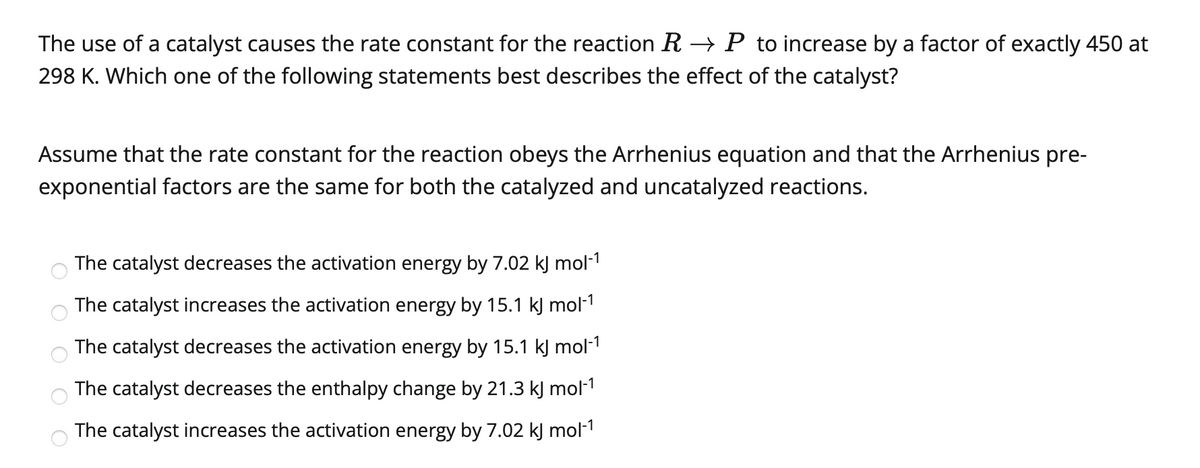The use of a catalyst causes the rate constant for the reaction R → P to increase by a factor of exactly 450 at 298 K. Which one of the following statements best describes the effect of the catalyst? Assume that the rate constant for the reaction obeys the Arrhenius equation and that the Arrhenius pre- exponential factors are the same for both the catalyzed and uncatalyzed reactions. The catalyst decreases the activation energy by 7.02 kJ mol-1 The catalyst increases the activation energy by 15.1 k) mol1 The catalyst decreases the activation energy by 15.1 kJ mol-1 The catalyst decreases the enthalpy change by 21.3 kJ mol-1 The catalyst increases the activation energy by 7.02 kJ mol1
The use of a catalyst causes the rate constant for the reaction R → P to increase by a factor of exactly 450 at 298 K. Which one of the following statements best describes the effect of the catalyst? Assume that the rate constant for the reaction obeys the Arrhenius equation and that the Arrhenius pre- exponential factors are the same for both the catalyzed and uncatalyzed reactions. The catalyst decreases the activation energy by 7.02 kJ mol-1 The catalyst increases the activation energy by 15.1 k) mol1 The catalyst decreases the activation energy by 15.1 kJ mol-1 The catalyst decreases the enthalpy change by 21.3 kJ mol-1 The catalyst increases the activation energy by 7.02 kJ mol1
Chemistry: The Molecular Science
5th Edition
ISBN:9781285199047
Author:John W. Moore, Conrad L. Stanitski
Publisher:John W. Moore, Conrad L. Stanitski
Chapter11: Chemical Kinetics: Rates Of Reactions
Section: Chapter Questions
Problem 11.ACP: (Section 11-5) A rule of thumb is that for a typical reaction, if concentrations are unchanged, a...
Related questions
Question
6

Transcribed Image Text:The use of a catalyst causes the rate constant for the reaction R → P to increase by a factor of exactly 450 at
298 K. Which one of the following statements best describes the effect of the catalyst?
Assume that the rate constant for the reaction obeys the Arrhenius equation and that the Arrhenius pre-
exponential factors are the same for both the catalyzed and uncatalyzed reactions.
The catalyst decreases the activation energy by 7.02 kJ mol-1
The catalyst increases the activation energy by 15.1 kJ mol-1
The catalyst decreases the activation energy by 15.1 kJ mol-1
The catalyst decreases the enthalpy change by 21.3 kJ mol-1
The catalyst increases the activation energy by 7.02 kJ mol-1
O O O
Expert Solution
This question has been solved!
Explore an expertly crafted, step-by-step solution for a thorough understanding of key concepts.
Step by step
Solved in 3 steps with 2 images

Knowledge Booster
Learn more about
Need a deep-dive on the concept behind this application? Look no further. Learn more about this topic, chemistry and related others by exploring similar questions and additional content below.Recommended textbooks for you

Chemistry: The Molecular Science
Chemistry
ISBN:
9781285199047
Author:
John W. Moore, Conrad L. Stanitski
Publisher:
Cengage Learning

Chemistry
Chemistry
ISBN:
9781305957404
Author:
Steven S. Zumdahl, Susan A. Zumdahl, Donald J. DeCoste
Publisher:
Cengage Learning

Chemistry for Engineering Students
Chemistry
ISBN:
9781337398909
Author:
Lawrence S. Brown, Tom Holme
Publisher:
Cengage Learning

Chemistry: The Molecular Science
Chemistry
ISBN:
9781285199047
Author:
John W. Moore, Conrad L. Stanitski
Publisher:
Cengage Learning

Chemistry
Chemistry
ISBN:
9781305957404
Author:
Steven S. Zumdahl, Susan A. Zumdahl, Donald J. DeCoste
Publisher:
Cengage Learning

Chemistry for Engineering Students
Chemistry
ISBN:
9781337398909
Author:
Lawrence S. Brown, Tom Holme
Publisher:
Cengage Learning

Chemistry & Chemical Reactivity
Chemistry
ISBN:
9781133949640
Author:
John C. Kotz, Paul M. Treichel, John Townsend, David Treichel
Publisher:
Cengage Learning

Chemistry & Chemical Reactivity
Chemistry
ISBN:
9781337399074
Author:
John C. Kotz, Paul M. Treichel, John Townsend, David Treichel
Publisher:
Cengage Learning
